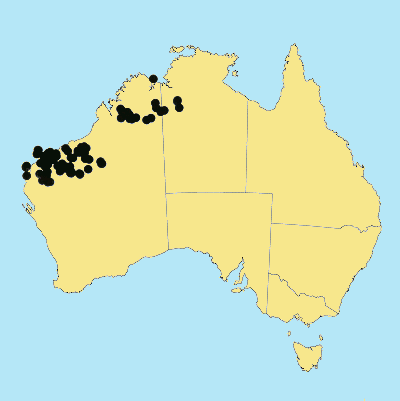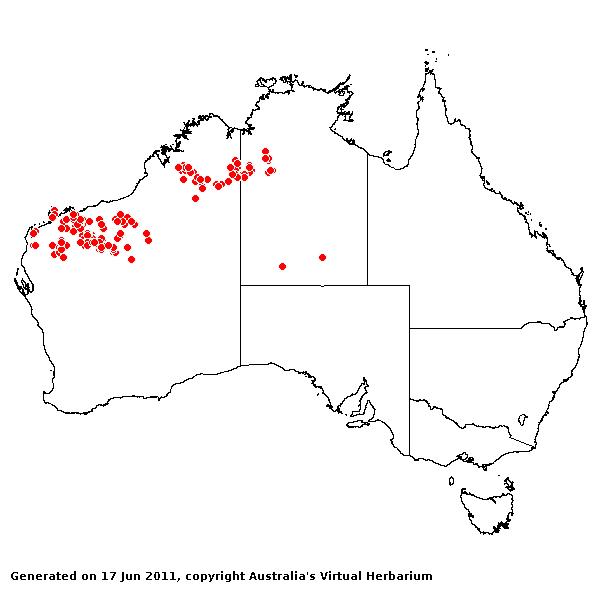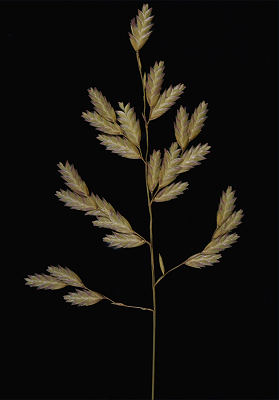Triodia wiseana C.A.Gardner. J. Roy. Soc. Western Australia 28: 166 (1942).
Classification. (GPWG 2001) : Subfamily Chloridoideae. Triodeae.
Type of Basionym or
Protologue Information: Australia: Mount Margaret Pass, Hamersley Range, C.A.
Gardner 3129 (HT: PERTH; IT: CANB).
Key references
(books and floras): [1952] C.A.Gardner, Flora of Western Australia 1
Gramineae (74), [2002] D.Sharp & B.K.Simon, AusGrass, Grasses of
Australia.
Illustrations:
[1952] C.A.Gardner, Flora of Western Australia 1 Gramineae (70,
Pl. 20).
Habit.
Perennial. Stolons absent or present. Culms 30–120 cm tall. Mid-culm internodes
glabrous. Leaf-sheaths glabrous on surface or hairy. Leaf-sheath auricles
absent. Ligule a fringe of hairs. Leaf-blades curved or flexuous, aciculate,
conduplicate, 4.5–30 cm long, 0.8–1.3 mm wide.
Inflorescence.
Inflorescence compound, a panicle. Panicle linear or oblong, dense, (5–)9–35 cm
long, 1.5–3(–6) cm wide.
Spikelets.
Spikelets sessile or pedicelled. Fertile spikelets many flowered, with at least
2 fertile florets (5–9), comprising 5–9 fertile floret(s), with diminished
florets at the apex, lanceolate or oblong, laterally compressed or terete, 7–19
mm long.
Glumes.
Glumes similar, thinner than fertile lemma. Lower glume lanceolate or oblong,
scarious or cartilaginous or indurate, keeled, 1-keeled, 3–5 -nerved. Lower
glume surface glabrous. Lower glume apex muticous or mucronate. Upper glume
lanceolate or oblong, 4.5–9 mm long, scarious or cartilaginous or indurate,
keeled, 1-keeled, 3–5 -nerved. Upper glume surface smooth or asperulous,
glabrous. Upper glume apex muticous or mucronate.
Florets.
Fertile lemma 4–7.5 mm long, without keel, 9–10 -nerved. Lemma surface glabrous
or indumented. Lemma apex lobed, muticous. Anthers 3.
Continental
Distribution: Australasia.
Australian
Distribution: Western Australia, Northern Territory.
Western Australia:
Fitzgerald, Hall, Dampier. Keartland, Carnegie, Fortescue, Ashburton,
Carnarvon. Eucla, Avon. Northern Territory: Victoria River.
Notes.
Distinguished by the sparsely hairy lemmas, with usually deep subulate lobes;
usually glabrous, relatively long paleas with prominently winged keels;
strongly 3-nerved glumes; paniculate inflorescence; indumentum of long,
straight, stiff hairs on orifice, which extend along margins of blades in
tubercular-based clusters.
Mainland
and islands of NW W.A. (N of 24°S) and areas of N.T. adjacent to East Gardner
and Hall Districts of the Kimberley Region. Commonly in shallow and skeletal,
rocky soils and gullies on hills, ridges, plateaux, mountains, ranges, gorges
and outcrops of limestone; also in association with granite, sandstone,
quartzite, shale, schist, basalt, chert and laterite; in alluvial, red stony
clay loam, coarse sandy and gravelly soils on plains and gentle slopes, stony
downs, sandplains, valley floors, grass steppes, creek beds, floodouts and
banks, and drainage lines; flowers all seasons.





